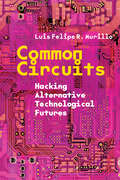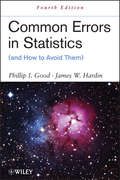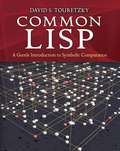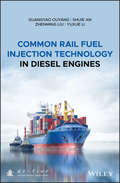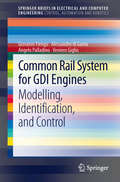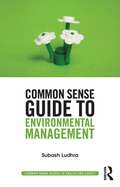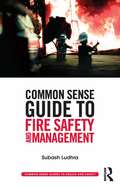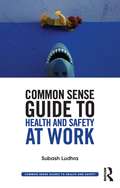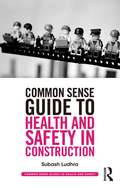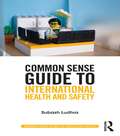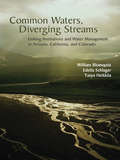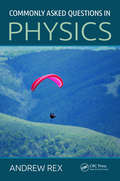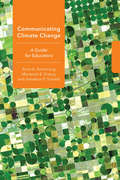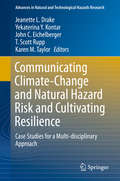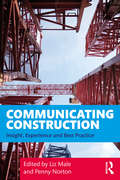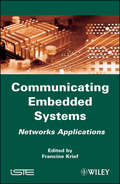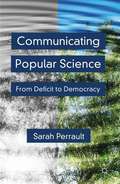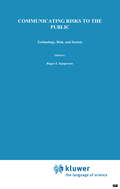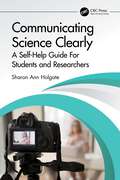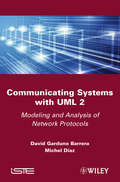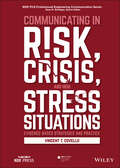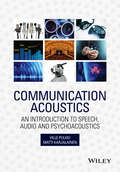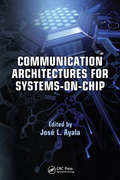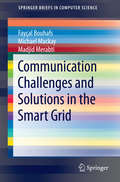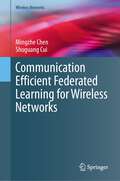- Table View
- List View
Common Circuits: Hacking Alternative Technological Futures
by Luis Felipe MurilloHow hackers facilitate community technology projects that counter the monoculture of "big tech" and point us to brighter, innovative horizons. A digital world in relentless movement—from artificial intelligence to ubiquitous computing—has been captured and reinvented as a monoculture by Silicon Valley "big tech" and venture capital firms. Yet very little is discussed in the public sphere about existing alternatives. Based on long-term field research across San Francisco, Tokyo, and Shenzhen, Common Circuits explores a transnational network of hacker spaces that stand as potent, but often invisible, alternatives to the dominant technology industry. In what ways have hackers challenged corporate projects of digital development? How do hacker collectives prefigure more just technological futures through community projects? Luis Felipe R. Murillo responds to these urgent questions with an analysis of the hard challenges of collaborative, autonomous community-making through technical objects conceived by hackers as convivial, shared technologies. Through rich explorations of hacker space histories and biographical sketches of hackers who participate in them, Murillo describes the social and technical conditions that allowed for the creation of community projects such as anonymity and privacy networks to counter mass surveillance; community-made monitoring devices to measure radioactive contamination; and small-scale open hardware fabrication for the purposes of technological autonomy. Murillo shows how hacker collectives point us toward brighter technological futures—a renewal of the "digital commons"—where computing projects are constantly being repurposed for the common good.
Common Errors in Statistics (and How to Avoid Them): Introduction To Statistics Through Resampling Methods And Microsoft Office Excel
by Phillip I. Good James W. HardinPraise for Common Errors in Statistics (and How to Avoid Them) "A very engaging and valuable book for all who use statistics in any setting." —CHOICE "Addresses popular mistakes often made in data collection and provides an indispensable guide to accurate statistical analysis and reporting. The authors' emphasis on careful practice, combined with a focus on the development of solutions, reveals the true value of statistics when applied correctly in any area of research." —MAA Reviews Common Errors in Statistics (and How to Avoid Them), Fourth Edition provides a mathematically rigorous, yet readily accessible foundation in statistics for experienced readers as well as students learning to design and complete experiments, surveys, and clinical trials. Providing a consistent level of coherency throughout, the highly readable Fourth Edition focuses on debunking popular myths, analyzing common mistakes, and instructing readers on how to choose the appropriate statistical technique to address their specific task. The authors begin with an introduction to the main sources of error and provide techniques for avoiding them. Subsequent chapters outline key methods and practices for accurate analysis, reporting, and model building. The Fourth Edition features newly added topics, including: Baseline data Detecting fraud Linear regression versus linear behavior Case control studies Minimum reporting requirements Non-random samples The book concludes with a glossary that outlines key terms, and an extensive bibliography with several hundred citations directing readers to resources for further study. Presented in an easy-to-follow style, Common Errors in Statistics, Fourth Edition is an excellent book for students and professionals in industry, government, medicine, and the social sciences.
Common LISP: A Gentle Introduction to Symbolic Computation
by David S. TouretzkyThis highly accessible introduction to Lisp is suitable both for novices approaching their first programming language and experienced programmers interested in exploring a key tool for artificial intelligence research. The text offers clear, reader-friendly explanations of such essential concepts as cons cell structures, evaluation rules, programs as data, and recursive and applicative programming styles. The treatment incorporates several innovative instructional devices, such as the use of function boxes in the first two chapters to visually distinguish functions from data, use of evaltrace notation in later chapters to illustrate the operation of evaluation rules, and "Dragon stories" to explain recursion. The book contains nearly 400 diagrams and illustrations, and 77 pages of answers to exercises. Advanced topics and "toolkit" sections, and a variety of complete programs, extend readers' programming power.
Common Rail Fuel Injection Technology in Diesel Engines
by Guangyao Ouyang Shijie An Zhenming Liu Yuxue LiA wide-ranging and practical handbook that offers comprehensive treatment of high-pressure common rail technology for students and professionals In this volume, Dr. Ouyang and his colleagues answer the need for a comprehensive examination of high-pressure common rail systems for electronic fuel injection technology, a crucial element in the optimization of diesel engine efficiency and emissions. The text begins with an overview of common rail systems today, including a look back at their progress since the 1970s and an examination of recent advances in the field. It then provides a thorough grounding in the design and assembly of common rail systems with an emphasis on key aspects of their design and assembly as well as notable technological innovations. This includes discussion of advancements in dual pressure common rail systems and the increasingly influential role of Electronic Control Unit (ECU) technology in fuel injector systems. The authors conclude with a look towards the development of a new type of common rail system. Throughout the volume, concepts are illustrated using extensive research, experimental studies and simulations. Topics covered include: Comprehensive detailing of common rail system elements, elementary enough for newcomers and thorough enough to act as a useful reference for professionals Basic and simulation models of common rail systems, including extensive instruction on performing simulations and analyzing key performance parameters Examination of the design and testing of next-generation twin common rail systems, including applications for marine diesel engines Discussion of current trends in industry research as well as areas requiring further study Common Rail Fuel Injection Technology is the ideal handbook for students and professionals working in advanced automotive engineering, particularly researchers and engineers focused on the design of internal combustion engines and advanced fuel injection technology. Wide-ranging research and ample examples of practical applications will make this a valuable resource both in education and private industry.
Common Rail System for GDI Engines: Modelling, Identification, and Control (SpringerBriefs in Electrical and Computer Engineering)
by Angelo Palladino Alessandro Di Gaeta Veniero Giglio Giovanni FiengoProgressive reductions in vehicle emission requirements have forced the automotive industry to invest in research and development of alternative control strategies. Continual control action exerted by a dedicated electronic control unit ensures that best performance in terms of pollutant emissions and power density is married with driveability and diagnostics. Gasoline direct injection (GDI) engine technology is a way to attain these goals. This brief describes the functioning of a GDI engine equipped with a common rail (CR) system, and the devices necessary to run test-bench experiments in detail. The text should prove instructive to researchers in engine control and students are recommended to this brief as their first approach to this technology. Later chapters of the brief relate an innovative strategy designed to assist with the engine management system; injection pressure regulation for fuel pressure stabilization in the CR fuel line is proposed and validated by experiment. The resulting control scheme is composed of a feedback integral action and a static model-based feed-forward action, the gains of which are scheduled as a function of fundamental plant parameters. The tuning of closed-loop performance is supported by an analysis of the phase-margin and the sensitivity function. Experimental results confirm the effectiveness of the control algorithm in regulating the mean-value rail pressure independently from engine working conditions (engine speed and time of injection) with limited design effort.
Common Sense Guide to Environmental Management
by Subash LudhraAn essential and short guide for those who need to know more about environmental management in the workplace without wanting to spend hours reading dozens of different documents. Whether it’s for use alongside a training course or simply to brush up on your knowledge, it’s perfect for equipping you with the principles of environmental management. Friendly and accessible, this Common Sense Guide covers all the main aspects of environmental management in manageable chapters to provide you with the knowledge and understanding you need to look after the environment and those around you. Suitable for those with little understanding of environmental management Includes questions at the end of each module to consolidate your environmental management knowledge Certificate offered to those who complete the exam at the end of the book and return to be marked externally.
Common Sense Guide to Fire Safety and Management
by Subash LudhraAn essential and short guide for those who need to know more about fire safety and management without wanting to spend hours reading dozens of different documents. Whether it’s for use alongside a training course or simply to brush up on your knowledge, it’s perfect for equipping you with the principles of fire safety. Friendly and accessible, this Common Sense Guide covers all the main aspects of fire safety and management in manageable chapters to provide you with the knowledge and understanding you need to look after yourself and others. Suitable for those with little understanding of fire safety and management Includes questions at the end of each module to consolidate your fire safety knowledge Certificate offered to those who complete the exam at the end of the book and return to be marked externally.
Common Sense Guide to Health & Safety at Work
by Subash LudhraAn essential and short guide for employees who need to know more about health and safety in the workplace without wanting to spend hours reading dozens of different documents. Whether it’s for use alongside a training course or simply to brush up on your knowledge, it’s perfect for equipping you with the principles of health and safety. Friendly and accessible, this Common Sense Guide covers all the main aspects of health and safety in manageable chapters to provide you with the knowledge and understanding you need to look after yourself and others in the workplace. Suitable for the non-health and safety professional Includes questions at the end of each module to consolidate your health and safety knowledge Certificate offered to those who complete the exam at the end of the book and return to be marked externally.
Common Sense Guide to Health and Safety in Construction
by Subash LudhraAn essential and short guide for employees who need to know more about health and safety within the construction industry without wanting to spend hours reading dozens of different documents. Whether it’s for use alongside a training course or simply to brush up on your knowledge, it’s perfect for equipping you with the principles of health and safety in the construction industry. Friendly and accessible, this Common Sense Guide covers all the main aspects of health and safety in manageable chapters to provide you with the knowledge and understanding you need to look after yourself and others working in construction. Suitable for the non-health and safety professional Includes questions at the end of each module to consolidate your health and safety knowledge Certificate offered to those who complete the exam at the end of the book and return to be marked externally.
Common Sense Guide to International Health and Safety
by Subash LudhraAn essential and short guide for employees who need to know more about international health and safety without wanting to spend hours reading dozens of different documents. Whether it’s for use alongside a training course or simply to brush up on your knowledge, it’s perfect for equipping you with the principles of international health and safety. Friendly and accessible, this Common Sense Guide covers all the main aspects of international health and safety in manageable chapters to provide you with the knowledge and understanding you need in the international workplace. Suitable for the non-health and safety professional Includes questions at the end of each module to consolidate your health and safety knowledge Certificate offered to those who complete the exam at the end of the book and return to be marked externally
Common Waters, Diverging Streams: Linking Institutions and Water Management in Arizona, California, and Colorado
by Tanya Heikkila William Blomquist Edella SchlagerThis book is a firsthand investigation into water management in a fast-growing region of the arid American West. It presents three states that have adopted the conjunctive management of groundwater and surface water to make resources go further in serving people and the environment. Yet conjunctive management has followed a different history, been practiced differently, and produced different outcomes in each state. The authors question why different results have emerged from neighbors trying to solve similar problems with the same policy reform. Common Waters, Diverging Streams makes several important contributions to policy literature and policymaking. The first book on conjunctive water management, it describes how the policy came into existence, how it is practiced, what it does and does not accomplish, and how institutional arrangements affect its application. A second contribution is the book's clear and persuasive links between institutions and policy outcomes. Scholars often declare that institutions matter, but few articles or books provide an explicit case study of how policy linkages work in actual practice. In contrast, Blomquist, Schlager, and Heikkila show how diverging courses in conjunctive water management can be explained by state laws and regulations, legal doctrines, the organizations governing and managing water supplies, and the division of authority between state and local government. Not only do these institutional structures make conjunctive management easier or harder to achieve, but they influence the kinds of problems people try to solve and the purposes for which they attempt conjunctive management.
Commonly Asked Questions in Physics
by Andrew RexIn the 300 years since Newton's seminal work, physics has explained many things that used to be mysterious. Particularly in the last century, physics has addressed a range of questions, from the smallest fundamental particles to the large-scale structure and history of the entire universe. But there are always more questions.Suitable for a wide aud
Communicating Climate Change: A Guide for Educators (Cornell Series in Environmental Education)
by Marianne E. Krasny Anne K. Armstrong Jonathon P. SchuldtEnvironmental educators face a formidable challenge when they approach climate change due to the complexity of the science and of the political and cultural contexts in which people live. There is a clear consensus among climate scientists that climate change is already occurring as a result of human activities, but high levels of climate change awareness and growing levels of concern have not translated into meaningful action. Communicating Climate Change provides environmental educators with an understanding of how their audiences engage with climate change information as well as with concrete, empirically tested communication tools they can use to enhance their climate change program.Starting with the basics of climate science and climate change public opinion, Armstrong, Krasny, and Schuldt synthesize research from environmental psychology and climate change communication, weaving in examples of environmental education applications throughout this practical book. Each chapter covers a separate topic, from how environmental psychology explains the complex ways in which people interact with climate change information to communication strategies with a focus on framing, metaphors, and messengers. This broad set of topics will aid educators in formulating program language for their classrooms at all levels. Communicating Climate Change uses fictional vignettes of climate change education programs and true stories from climate change educators working in the field to illustrate the possibilities of applying research to practice. Armstrong et al, ably demonstrate that environmental education is an important player in fostering positive climate change dialogue and subsequent climate change action.Thanks to generous funding from Cornell University, the ebook editions of this book are available as Open Access from Cornell Open (cornellopen.org) and other Open Access repositories.
Communicating Climate-Change and Natural Hazard Risk and Cultivating Resilience: Case Studies for a Multi-disciplinary Approach (Advances in Natural and Technological Hazards Research #45)
by Jeanette L. Drake Yekaterina Y. Kontar John C. Eichelberger T. Scott Rupp Karen M. TaylorThis edited volume emphasizes risk and crisis communication principles and practices within the up-to the minute context of new technologies, a new focus on resiliency, and global environmental change. It includes contributions from experts from around the globe whose research, advocacy, teaching, work, or service in the natural or social sciences deals with risk communication and/or management surrounding natural and technological disasters, with a particular focus on climate change-related phenomena. Resilience and good communication are intimately linked and with climate change precipitating more numerous and onerous weather-related catastrophes, a conversation on resilience is timely and necessary. The goal is robust communities that are able to withstand the shock of disaster. Communicating well under ordinary circumstances is challenging; communicating during a crisis is extraordinarily difficult. This book is dedicated to all those who have directly or indirectly suffered the effects of climate change end extreme events with the hope that the advance of knowledge, implementation of sound science and appropriate policies and use of effective communication will help in reducing their vulnerability while also improving resilience in the face of often devastating natural and technological disasters.
Communicating Construction: Insight, Experience and Best Practice
by Liz Male and Penny NortonThis book is a wide-ranging exploration of PR and communication in the construction industry, with a strong emphasis on communications theory, strategy and technique. The editors begin with an introduction to the UK construction industry and its supply chains, as well as various elements of PR in relation to the construction process. Subsequent chapters provide a strategic overview, practical examples, success stories, case studies and personal perspectives on PR for different parts of the built environment and reputational issues in construction. Chapters include expert advice on communications for architecture, planning, building consultancy, building products and manufacturers, general and specialist contractors, construction technology, infrastructure and communicating sustainability in the built environment. The conclusion looks at the current and upcoming reputational priorities for communicators in construction, as well as the top ten priorities for implementing PR as a strategic management discipline in the industry. This book is essential reading for all construction PR teams, students studying both for built environment and PR/marketing degrees and CPD courses, and anyone working in the built environment sector who needs to consider PR and marketing as part of their role.
Communicating Embedded Systems: Networks Applications
by Francine KriefEmbedded systems become more and more complex and require having some knowledge in various disciplines such as electronics, data processing, telecommunications and networks. Without detailing all the aspects related to the design of embedded systems, this book, which was written by specialists in electronics, data processing and telecommunications and networks, gives an interesting point of view of communication techniques and problems in embedded systems. This choice is easily justified by the fact that embedded systems are today massively communicating and that telecommunications and networks constitute the main sector of embedded systems.
Communicating Popular Science
by Sarah PerraultTechnoscientific developments often have far-reaching consequences, both negative and positive, for the public. Yet, because science has the authority to decide which judgments about scientific issues are sound, public concerns are often dismissed because they are not part of the technoscientific paradigm they question. This book addresses the role of science popularization in that paradox; it explains how science writing works and argues that it can do better at promoting public discussions about science-related issues. To support these arguments, it situates science popularization in its historical and cultural context; provides a conceptual framework for analyzing popular science texts; and examines the rhetorical effects of common strategies used in popular science writing. Twenty-six years after Dorothy Nelkin's groundbreaking book, Selling Science: How the Press Covers Science and Technology, popular science writing is still not meeting its potential as a public interest genre; Communicating Popular Science explores how it can move closer to doing so.
Communicating Risks to the Public: International Perspectives (Risk, Governance and Society #4)
by R. E Kasperson P. J. StallenRisk communication: the evolution of attempts Risk communication is at once a very new and a very old field of interest. Risk analysis, as Krimsky and Plough (1988:2) point out, dates back at least to the Babylonians in 3200 BC. Cultures have traditionally utilized a host of mecha nisms for anticipating, responding to, and communicating about hazards - as in food avoidance, taboos, stigma of persons and places, myths, migration, etc. Throughout history, trade between places has necessitated labelling of containers to indicate their contents. Seals at sites of the ninth century BC Harappan civilization of South Asia record the owner and/or contents of the containers (Hadden, 1986:3). The Pure Food and Drug Act, the first labelling law with national scope in the United States, was passed in 1906. Common law covering the workplace in a number of countries has traditionally required that employers notify workers about significant dangers that they encounter on the job, an obligation formally extended to chronic hazards in the OSHA's Hazard Communication regulation of 1983 in the United States. In this sense, risk communication is probably the oldest way of risk manage ment. However, it is only until recently that risk communication has attracted the attention of regulators as an explicit alternative to the by now more common and formal approaches of standard setting, insuring etc. (Baram, 1982).
Communicating Science Clearly: A Self-Help Guide For Students and Researchers
by Sharon Ann HolgateThis unique self-help guide equips undergraduates, postgraduate students, and early career researchers within the sciences with transferrable communication skills that they can adapt and refer back to as they progress through their careers. It provides practical guidance on how to best communicate science in a range of different settings. This book facilitates clear and concise communication in both academic scenarios and the workplace. It covers settings ranging from job interviews, through conference presentations, to explaining your research to the general public. It is illustrated with first-hand experiences, top tips, and "dos and don’ts" to demonstrate best practices. It will also be a valuable guide for established academics who would like a refresher or a guide to new avenues of science communication, such as podcasts. Key Features: Written by an award-winning professional science journalist and broadcaster with 25 years’ experience, including writing for national newspapers, devising and presenting programmes for BBC Radio 4, and being interviewed on radio, TV, video, and podcasts Covers science communication in a broad range of settings including peer-to-peer, to your manager, at job interviews, and during media appearances Includes advice from a range of experts who communicate professionally, including a radio producer, a TV presenter, actors and entertainers, and scientists Additional video material to accompany this book can be found here: https://www.youtube.com/playlist?list=PLLUWyRwmgFlW7_NrNupeuiJ86OxIWHZ6I. Sharon Ann Holgate is a freelance science writer and broadcaster. She has presented on BBC Radio 4 and the BBC World Service, and presented video podcasts for medical research charity the Myrovlytis Trust. She earned a D.Phil in physics from the University of Sussex, where she was a Visiting Fellow in Physics and Astronomy for nine years. Her articles have appeared in Science, Science Careers, New Scientist, The Times Higher Education Supplement, The Times Literary Supplement, Flipside, E&T, Focus, Physics World, Interactions, Materials World, Modern Astronomer, and Astronomy Now. She was also shortlisted for the radio programme category of the Association of British Science Writers' Awards in 2005, and for the Aventis Prizes for Science Books Junior Prize in 2003. Dr. Holgate was the recipient of the Institute of Physics 2022 William Thomson, Lord Kelvin Medal and Prize for communicating science to a wide variety of audiences and for positive representations of scientists from non-traditional backgrounds. She has also received the Institute of Physics Young Professional Physicist of the Year Award and a Merit Award in the Daily Telegraph Young Science Writer of the Year competition. She is the author of the undergraduate textbook Understanding Solid State Physics, which is currently in its second edition and used as a core text in universities around the world.
Communicating Systems with UML 2: Modeling and Analysis of Network Protocols (Wiley-iste Ser.)
by David Garduno Barrera Michel DiazThis book gives a practical approach to modeling and analyzing communication protocols using UML 2. Network protocols are always presented with a point of view focusing on partial mechanisms and starting models. This book aims at giving the basis needed for anybody to model and validate their own protocols. It follows a practical approach and gives many examples for the description and analysis of well known basic network mechanisms for protocols. The book firstly shows how to describe and validate the main protocol issues (such as synchronization problems, client-server interactions, layer organization and behavior, etc.) in an easy and understandable way. To do so, the book considers and presents the main traditional network examples (e.g. unidirectional flows, full-duplex com-munication, error recovering, alternating bit). Finally, it presents the outputs resulting from a few simulations of these UML models. Other books usually only focus either on teaching UML or on analyzing network protocols, however this book will allow readers to model network protocols using a new perspective and integrating these two views, so facilitating their comprehension and development. Any university student studying in the field of computing science, or those working in telecommunications, embedded systems or networking will find this book a very useful addition.
Communicating in Risk, Crisis, and High Stress Situations: Evidence-Based Strategies and Practice (IEEE PCS Professional Engineering Communication Series)
by Vincent T. CovelloCOMMUNICATING IN R!SK, CRISIS, AND HIGH STRESS SITUATIONS LEARN THE UNIFYING PRINCIPLES BEHIND RISK, CRISIS, AND HIGH STRESS COMMUNICATION WITH THIS STATE-OF-THE-ART REFERENCE WRITTEN BY A MAJOR LEADER IN THE FIELD Communicating in Risk, Crisis, and High Stress Situations: Evidence-Based Strategies and Practice is about communicating with people in the most challenging circumstances: high stress situations characterized by high risks and high stakes. The ability to communicate effectively in a high stress situation is an essential communication competency for managers, engineers, scientists, and professionals in every field who can be thrust into demanding situations complicated by stress. Whether you are confronting an external crisis, an internal emergency, or leading organizational change, this book was written for you. Communicating in Risk, Crisis, and High Stress Situations brings together in one resource proven scientific research with practical, hands-on guidance from a world leader in the field. The book covers such critical topics as trust, stakeholder engagement, misinformation, messaging, and audience perceptions in the context of stress. This book is uniquely readable, thorough, and useful, thanks to features that include: Evidence-based theories and concepts that underlie and guide practice Tools and guidelines for practical and effective planning and application Experience-based advice for facing challenges posed by mainstream and social media Provocative case studies that bring home the key principles and strategies Illuminating case diaries that use the author’s breadth and depth of experience to create extraordinary learning opportunities The book is a necessity for managers, engineers, scientists, and others who must communicate difficult technical concepts to a concerned public. It also belongs on the bookshelves of leaders and communicators in public and private sector organizations looking for a one-stop reference and evidence-based practical guide for communicating effectively in emotionally charged situations. Written by a highly successful academic, consultant, and trainer, the book is also designed as a resource for training and education.
Communication Acoustics
by Matti Karjalainen Ville Pulkkid for speech and audio quality evaluation.
Communication Architectures for Systems-on-Chip (Embedded Systems)
by José L. AyalaA presentation of state-of-the-art approaches from an industrial applications perspective, Communication Architectures for Systems-on-Chip shows professionals, researchers, and students how to attack the problem of data communication in the manufacture of SoC architectures. With its lucid illustration of current trends and research improving the performance, quality, and reliability of transactions, this is an essential reference for anyone dealing with communication mechanisms for embedded systems, systems-on-chip, and multiprocessor architectures—or trying to overcome existing limitations. Exploring architectures currently implemented in manufactured SoCs—and those being proposed—this book analyzes a wide range of applications, including: Well-established communication buses Less common networks-on-chip Modern technologies that include the use of carbon nanotubes (CNTs) Optical links used to speed up data transfer and boost both security and quality of service (QoS) The book’s contributors pay special attention to newer problems, including how to protect transactions of critical on-chip information (personal data, security keys, etc.) from an external attack. They examine mechanisms, revise communication protocols involved, and analyze overall impact on system performance.
Communication Challenges and Solutions in the Smart Grid (SpringerBriefs in Computer Science)
by Fayҫal Bouhafs Michael Mackay Madjid MerabtiThis SpringerBrief discusses the rise of the smart grid from the perspective of computing and communications. It explains how current and next-generation network technology and methodologies help recognize the potential that the smart grid initiative promises. Chapters provide context on the smart grid before exploring specific challenges related to communication control and energy management. Topics include control in heterogeneous power supply, solutions for backhaul and wide area networks, home energy management systems, and technologies for smart energy management systems. Designed for researchers and professionals working on the smart grid, Communication Challenges and Solutions in the Smart Grid offers context and applications for the common issues of this developing technology. Advanced-level students interested in networking and communications engineering will also find the brief valuable.
Communication Efficient Federated Learning for Wireless Networks (Wireless Networks)
by Shuguang Cui Mingzhe ChenThis book provides a comprehensive study of Federated Learning (FL) over wireless networks. It consists of three main parts: (a) Fundamentals and preliminaries of FL, (b) analysis and optimization of FL over wireless networks, and (c) applications of wireless FL for Internet-of-Things systems. In particular, in the first part, the authors provide a detailed overview on widely-studied FL framework. In the second part of this book, the authors comprehensively discuss three key wireless techniques including wireless resource management, quantization, and over-the-air computation to support the deployment of FL over realistic wireless networks. It also presents several solutions based on optimization theory, graph theory and machine learning to optimize the performance of FL over wireless networks. In the third part of this book, the authors introduce the use of wireless FL algorithms for autonomous vehicle control and mobile edge computing optimization. Machine learning and data-driven approaches have recently received considerable attention as key enablers for next-generation intelligent networks. Currently, most existing learning solutions for wireless networks rely on centralizing the training and inference processes by uploading data generated at edge devices to data centers. However, such a centralized paradigm may lead to privacy leakage, violate the latency constraints of mobile applications, or may be infeasible due to limited bandwidth or power constraints of edge devices. To address these issues, distributing machine learning at the network edge provides a promising solution, where edge devices collaboratively train a shared model using real-time generated mobile data. The avoidance of data uploading to a central server not only helps preserve privacy but also reduces network traffic congestion as well as communication cost. Federated learning (FL) is one of most important distributed learning algorithms. In particular, FL enables devices to train a shared machine learning model while keeping data locally. However, in FL, training machine learning models requires communication between wireless devices and edge servers over wireless links. Therefore, wireless impairments such as noise, interference, and uncertainties among wireless channel states will significantly affect the training process and performance of FL. For example, transmission delay can significantly impact the convergence time of FL algorithms. In consequence, it is necessary to optimize wireless network performance for the implementation of FL algorithms.This book targets researchers and advanced level students in computer science and electrical engineering. Professionals working in signal processing and machine learning will also buy this book.
